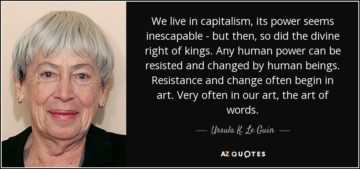by Faculty

At twenty minutes before dismissal time, I can think of nothing else to say but, “Class is over for today.”
As they all begin to scatter, a tall blonde student with a pigtail coiled on her head like a hat comes forward to stand before my desk. She holds the copy of her just-returned essay by the corners flat against her jeans like an apron.
“I—” Her breath gives out.
I gather that she is disturbed about something.
“I’ve never gotten a C before.”
This is a first draft of the first paper during the first semester for a first-year student. Her sentences seem to have issued from a shredder. She doesn’t know a comma from a period from a semi-colon, a “there” from a “their” from a “they’re.” She writes “would of” and “may of.” But she was “considered an A student” in high school. Hence, her surprise this morning.
“You’ll get to rewrite that. That’s the whole point of this assignment.”
“I have to get at least a B in this class.”
I stack my books on top of each other and put the stack of books on top of my folders. I snatch my pen off the desk and shove it into my breast pocket.
“If I don’t get a B, I’ll lose my funding.”
“You’ll get to rewrite the paper.”
#
My teaching gig is part-time, and I’ve been known to work as many as three jobs at once — Emergency Medical Technician for about fifteen years, plasterer and wallpaperer while my spouse still had his historic restoration business, small-scale vegetable and apple farmer, cemetery superintendent at present. My academic CV fits on one side of an 8.5 X 11 sheet of paper. When my fiction writing aspirations crashed, I took up old time fiddling. I drink cheap domestic red wine out of a Mason jar with an ice cube in it.
“Adjunct” is the perfectly suitable, adjective-turned-noun describing academic part-timers like me. It sounds like a vestigial body part. Read more »




 To understand the origins of any franchise, look first to rights—who owns the intellectual property, how it is managed, and where the revenue generated from its exploitation is set to flow.
To understand the origins of any franchise, look first to rights—who owns the intellectual property, how it is managed, and where the revenue generated from its exploitation is set to flow. There are five fundamental operations in mathematics,” the German mathematician Martin Eichler supposedly said. “Addition, subtraction, multiplication, division and modular forms.”
There are five fundamental operations in mathematics,” the German mathematician Martin Eichler supposedly said. “Addition, subtraction, multiplication, division and modular forms.” Huda Dahbour was 35 years old when she moved with her husband and three children to the West Bank in September 1995. It was the second anniversary of the Oslo accords, which established pockets of Palestinian self-government in the occupied territories. Jerusalem was still relatively open when they arrived in East Sawahre, a neighbourhood just outside the areas of Jerusalem that
Huda Dahbour was 35 years old when she moved with her husband and three children to the West Bank in September 1995. It was the second anniversary of the Oslo accords, which established pockets of Palestinian self-government in the occupied territories. Jerusalem was still relatively open when they arrived in East Sawahre, a neighbourhood just outside the areas of Jerusalem that 
 In The Odyssey, Odysseus and his crew are forced to navigate a strait bounded by two equally dangerous obstacles: Scylla, a six-headed sea serpent, and Charybdis, an underwater horror that sucks down ships through a massive whirlpool. Judging Charybdis to be a greater danger to the crew as a whole, Odysseus orders his crew to try and pass through on Scylla’s side. They make it, but six sailors are eaten in the crossing. In their new book Tyranny of the Minority, Harvard political scientists Steven Levitsky and Daniel Ziblatt — the authors of How Democracies Die — argue America’s founders faced an analogous problem: navigating between two types of dictatorship that threatened to devour the new country.
In The Odyssey, Odysseus and his crew are forced to navigate a strait bounded by two equally dangerous obstacles: Scylla, a six-headed sea serpent, and Charybdis, an underwater horror that sucks down ships through a massive whirlpool. Judging Charybdis to be a greater danger to the crew as a whole, Odysseus orders his crew to try and pass through on Scylla’s side. They make it, but six sailors are eaten in the crossing. In their new book Tyranny of the Minority, Harvard political scientists Steven Levitsky and Daniel Ziblatt — the authors of How Democracies Die — argue America’s founders faced an analogous problem: navigating between two types of dictatorship that threatened to devour the new country. A strange, immortal tube-shaped animal has been discovered to regenerate a whole new body from only its mouth to avoid getting old. This creature, named Hydractinia symbiolongicarpus, a tiny invertebrate that lives on the shells of crabs, is usually immune to aging altogether, but was found to use aging within its body to grow an entirely new body, a study published in the
A strange, immortal tube-shaped animal has been discovered to regenerate a whole new body from only its mouth to avoid getting old. This creature, named Hydractinia symbiolongicarpus, a tiny invertebrate that lives on the shells of crabs, is usually immune to aging altogether, but was found to use aging within its body to grow an entirely new body, a study published in the Justin H. Vassallo in American Affairs:
Justin H. Vassallo in American Affairs: At its core, goth is an alternative lifestyle that finds beauty in the dark and melancholy aspects of life, using music, literature and cinema as guideposts. It can be a mere fashion preference, but for the fully committed, it’s a design for life. Lol Tolhurst, a longtime adherent, believes it is “a way to understand the world” – and as relevant a form of cultural rebellion now as it was in the 1980s. Goth: A History eloquently presents his case, up to his concluding assertion that goth’s “beautiful, bleak wave of art” is an ideal form of resistance against “the terrible slide our world is taking toward oppressive authoritarianism”. At the very least, he argues, “something good” will come of it, though he doesn’t say what.
At its core, goth is an alternative lifestyle that finds beauty in the dark and melancholy aspects of life, using music, literature and cinema as guideposts. It can be a mere fashion preference, but for the fully committed, it’s a design for life. Lol Tolhurst, a longtime adherent, believes it is “a way to understand the world” – and as relevant a form of cultural rebellion now as it was in the 1980s. Goth: A History eloquently presents his case, up to his concluding assertion that goth’s “beautiful, bleak wave of art” is an ideal form of resistance against “the terrible slide our world is taking toward oppressive authoritarianism”. At the very least, he argues, “something good” will come of it, though he doesn’t say what.